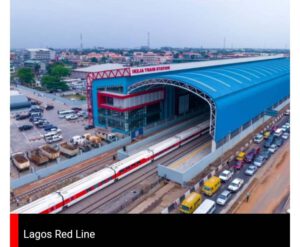By Uche Nnadozie
Penultimate week, Governor Babajide Sanwo-Olu commissioned the last major infrastructure piece for the Lagos Red Line rail project. The infrastructure is the trademark over-pass or fly over at the Ogunmokun axis in Mushin – a densely populated city in the state.
The bridge was built to ensure there is no vehicular or human interaction to the metro service. With this project, relief has been brought to commuters connecting Agege Motor Road towards Oshodi or Surulere on one hand, and the Onipanu and Ikorodu Road areas.
As part of the project in Mushin alone, a school – Mushin Primary School on Ogunmokun Street around the train station and the bridge – was relocated but reconstructed with modern classroom blocks and positively demure environment.
The Red Line, which was started by Sanwo-Olu in April 2021, includes the five overpasses built along the Red Line corridor – with Mushin being the last. Undertaken by Lagos Metropolitan Area Transport Authority (LAMATA), it has solved congestion and delays usually associated with railway level crossing at the Ogunmokun, Mushin axis. The overpass has also eliminated human and vehicular interference on the rail tracks, eradicating the risk of accidents and collisions between pedestrians, trains and vehicles.

The Sanwo-Olu administration had opened four other bridges in Yaba, Oyingbo, Ikeja and Agege along the 37km Red Line corridor to create new connectivities along the Lagos Rail Mass Transit (LRMT) from Agbado to Oyingbo.
The governor said the opening of the Mushin flyover was another fulfilment of his administration’s promise to the residents, noting that the infrastructure has changed the face of public transportation in the state reducing journey time in accessing Mushin from Ilupeju.
Sanwo-Olu said: “The Mushin overpass is strategically important for ease of movement and connectivity within Mushin and Onipanu communities, opening new routes to Agege Motor Road, Post Office Road and Ogunmokun axis. This infrastructure has brought not only traffic improvement, but also huge economic value to the area.
“With this new infrastructure, we have ensured there is minimal disruption on the Red Line corridor. For us, we have kept our promise to the citizens and made their lives better. The quality of infrastructure we have provided is about making the lives of our citizens better, improving their means of livelihood and quality of life”.
The governor noted that members of the host communities along the corridor benefited from the project construction, pointing out that LAMATA gave engineering students an internship opportunity to get first-hand practical knowledge from the project.
LAMATA Managing Director, Mrs. Abimbola Akinajo said the state government had fully compensated owners of the buildings in the course of the project, which, she said, was handled by a local contractor.
Meanwhile, there are eight stations along the Red Line corridor. Starting from Agbado, a border town between Ogun and Lagos states. Others are in Iju, Agege, Ikeja, Oshodi, Mushin, and Yaba, before terminating at Oyingbo.
These beautiful and easy-to-use train stations had already been commissioned along the corridor including the iconic Ikeja station from where commuters can link up with the airport which is just across the station. They can also connect the Lagos State University Teaching Hospital – a stone throw away, shopping malls, largest IT market in Africa (computer village), the Ikeja GRA, popular hotels and of course the state government secretariat, among others.
Residents and would-be commuters are eagerly awaiting the completion of test runs so that commercial activities can begin.